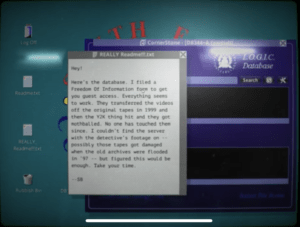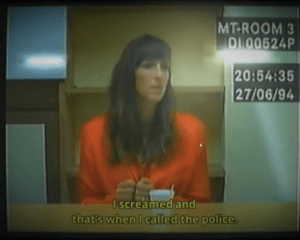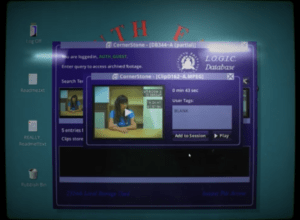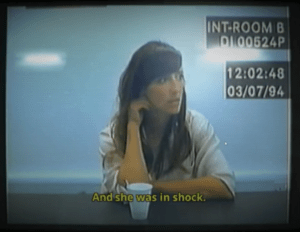
Introduction
Her Story is a game created by Sam Barlow that is available on several platforms such as iOS and PC. It is a game that tells a story through a collection of disjointed video clips. Players can view the video clips by entering queries of their choice into a police database. Slowly, the players can piece together a story.

Target Audience
The target audience of this game is people who enjoy the mystery and true crime genre as well as people who enjoy interactive stories. The non-linear nature of the game adds to the sense of mystery because players must piece together clues to understand more of the story. Since there are no clear objectives in the game except to try to understand the story, it also appeals to people who appreciate the storytelling aspect of games. There are many twists and surprises in the story, and playing the game is an immersive experience. The target audience age is most likely young adults since the main character is a young adult, and there are some mature themes.

Formal Elements
Players: This is a single-player game (single-player v. game) where you play as a guest who is looking through video footage in a police station database. There is a twist at the end of the story revealing that you are related to the woman in the video.
Procedures: When the game starts, the player is introduced to the mechanics through a “readme” text file. Next, players can start entering queries into the police station database and watching the corresponding videos. After the player has watched certain videos, they will be led to an ending scene with a chatbox.
Rules: The player must navigate through the police station database by entering queries into a textbox. The player makes progress by watching videos to piece together a story.
Outcomes: There is a formal ending to the game when the player has watched enough video clips and has watched some key video clips. During the ending scene, a chat window pops up on the computer asking if the player has found what they were looking for. Afterward, the game displays the end credits, and the player has the option to continue searching for video clips if they want to. So, the outcome of the game involves the player reaching the end scene.

Objectives: The objective of the game is to watch as many video clips as possible in order to figure out the story of the woman in the videos. There is a “Database Checker” tool that displays a grid indicating whether videos have been watched or not. An objective for the player could be to watch all of the videos, but this is not explicitly suggested in the game. Another objective could be to reach the ending scene. Overall, the game has an open-ended feel with no strict objectives.
Boundaries: The player is limited by only being able to watch the video clips in a segmented manner. They are also limited by only being able to see videos after they have entered a query into the database system and only being able to see the first 5 videos for each search term.
Conflict: A source of conflict in this game is needing to think of useful query terms to uncover more of the mystery. It offers an opportunity for a challenge, and I found myself thinking hard about what to use as a useful search term.

Resources: The player can “collect” more knowledge by watching videos. The content in the videos themselves acts as a type of resource that the player hopes to collect throughout the game to piece together the story.
Type of Fun
Narrative is the main type of fun in Her Story. The purpose of the game is to tell the story of a woman (who, depending on interpretation, could also be two different women!) through a series of video clips. At times, Her Story felt more like an interactive film than a video game. Discovery is another type of fun the game employs because players are able to discover new video clips as they try out new query terms.
Successes and Failures
Successes: The story was incredibly well written and executed. The acting was top-notch, and the body language of the actor made the videos seem like a real police investigation. It was interesting to see how immersive the story felt with a series of video clips with just one woman. The tone of the story was also present throughout the design of the game. The Y2K computer interface, computer screen glare, and occasional reflections on the screen added to the eerie, mysterious tone while reinforcing your role within the plotline as the character searches the database. There were many cross-references between the video clips, and the characters within the story were well thought out. Discovering new key information and twists to the story made the game very engaging.

Failures: The game didn’t provide much direction regarding how to play. On one hand, that design choice offers an opportunity for more player exploration and the potential for more immersion. However, I felt that it was sometimes unclear what to do next because of the lack of instructions and in-game goals. It also felt like the game didn’t have a solid stopping point.
Changes
I would change the game by adding more guidance to players on what to do, perhaps making use of the chatbox element throughout the game instead of only at the end of the game. I would also add more well-defined tasks/goals to complete. For example, the player could be required to find a specific piece of information to unlock a piece of information. These changes are helpful in guiding the player.


